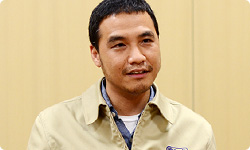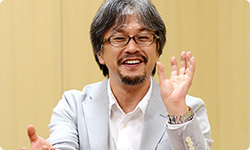2. Making the Characters
Haruhana-san, you were in charge of character design, while Takizawa-san, you were in charge of the enemies and bosses. How did you decide to divide up your roles like that?
Um...it just worked out that way.
When I first joined the team, I actually made a few of the enemies. But as I was working, I realised I wasn’t suited to it.
You weren’t good at making enemies?
It wasn’t really that I wasn’t good at it, but Takizawa-san was much better. He turned out so much great stuff that I naturally stepped aside! (laughs)
Which enemies did you make?
The Skulltula and Lizalfos.
Using skull and lizard themes.
Many characters in The Legend of Zelda games are incredibly distinctive.
Yes.
Where did all those unprecedented characters come from?
I was just innocently drawing away.
For example, did anyone tell you to make them distinctive?
No, but I would get tough requests - like a request to draw someone who would buy ghosts. But I’ve never seen anyone like that! (laughs) I’d think, “What kind of person would buy a ghost?” and then sit around, grinning to myself, and thinking, “What can I do about this?” It’s easy to focus on how the characters look, but I feel like they don’t really become distinctive until you see how they act when their dialogue and demo videos come together.

In other words, you’re not the only one who contributes to their characteristics.
Right. They’re a product of everyone working together.
So the extremely distinctive characters aren’t merely the result of your own output, but the result of everyone throwing in their ideas.
Right. My job is to give the characters shape at the start, but Osawa-san’s script has something like the unformed material in it.
The script contains in words the kind of function required of that character.
Right. I interpret for myself how I should design a character based on what kind of role that character plays. For example, I drew the Gorons who live on Death Mountain in the way that seemed best to me.
When you first gave them shape, I bet you wanted, somewhat mischievously, to get an exclamation from everyone.
Yes, that’s right. (laughs) First, I wanted the staff to love the design. Seeing whether I can put smiles on the faces of the people around me when I show them something I have innocently drawn is one filter I have. And if it feels right, then I play around with it along those lines and polish it up. I do that over and over.
A lot of distinctive characters have been born that way.
That’s right. But thinking back, I may not have been very hungry for that acceptance back then. What I mean is, I may have been a little weird back then, like I was on ‘automatic drawing mode’ or something.
Huh? You mean you were cranking out one character after the other?
I’m embarrassed to admit it, but yes. I just drew whatever popped into my head one after the other.
You’ve mentioned several times how you were “innocently” drawing, and I guess that’s what you meant.
Yes. I was just naturally scribbling away. I couldn’t see the goal because I was immersed in the world of The Legend of Zelda: Ocarina of Time and drawing with fervour.
I see.
But The Legend of Zelda: Ocarina of Time has lots of big environmental regions with lots of characters, so I figured in my own youthful way that there was a need to create a strong impression of which people were where.
There was a need to create characters that you would never forget once you saw them.
Right. For example, I made a considerable conscious effort to make sure players would remember who they would run into if they went around a particular corner. Since characters are essentially people, there’s a tendency to think that their faces are important, but I pay more attention to their figures. Sometimes I shape the figure first and then think about the face. Games can’t do much with just close-ups of the characters’ faces, so I think that what grabs people more than this or that facial characteristic is a memorable overall shape.
The Great Fairy is one character you never forget.
The Great Fairy is extremely flamboyant!
The first time I saw her, rather than smile, I drew back! (laughs)
(laughs)
She comes out with a laugh, so I thought she might show up in my dreams. (laughs) No one but Haruhana-san could draw a character like that!

Thanks. (laughs)
And it’s not like someone asked you up front to create an extremely garish fairy, right?
Right. If I drew a typical fairy, it would be boring. Like what I said earlier about figure, I think it’s important to have a gap between what you do and what everyone expects. So at the very least, I wanted to take a half-step in another direction.
That’s a half-step?! (laughs)
Huh? Oh, that’s about three, no, maybe four steps! (laughs)
(laughs)